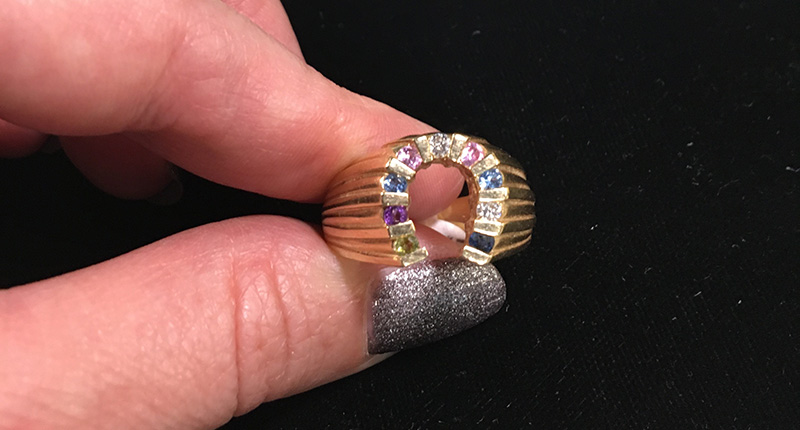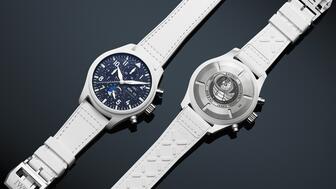Said to be the first to write a jewelry sales manual for the industry, Zell is remembered for his zest for life.
5 Tips for Buying Antique and Estate Jewelry
Dealers at The Original Miami Beach Antique Show dish on the telltale signs that something is a reproduction and the importance of experience.

Last week I was in Miami for The Original Miami Beach Antique Show and the following happened, in this order:
--I gave a talk on the history behind the squash blossom necklace at the Jewelry History Series with minimal heckling;
--I heard a number of other informative presentations, including one on World War II “Sweetheart Jewelry” by Jan Krulick and another from John P. Walcher of Chicago auction house Toomey & Co. on the jewelry made in the Windy City during the Arts & Crafts movement, particularly at The Kalo Shop;
--I saw some incredible jewelry (some of which is pictured here) and made great new friends; and
--I dipped my toes in the Atlantic Ocean (translation: I attempted to get only my feet wet but underestimated the waves and ended up with jeans soaked to the knees.)
Along the way, I stopped to chat with dealers at the show to get their advice on antique and estate jewelry buying for those who are opening a store (brick-and-mortar or online), taking over the buying responsibilities at an established store or looking to get into the business.
The advice I heard repeated most often wasn’t so much advice as it was a statement of fact: second-hand buying is mainly about experience. Being a good buyer comes from years of looking at and handling jewelry and, as with anything else, making mistakes along the way.
“The more you handle, the better you get,” New York-based dealer Hartley Brown told me at his booth while allowing me to handle some beautiful mandarin garnets. “It’s experience.”
And when I stopped by the booth of Kurt Rother of Los Angeles-based Excalibur on Saturday afternoon and asked him how to tell if a piece of allegedly antique jewelry is a reproduction, he summed it up like this: “years of experience.”
There were, however, a few specific tips that I was able to glean from the dealers I spoke with in Miami.
1. Examine the jewelry from all angles, carefully.
Look at the back of a piece of jewelry, Brown advised, not just the front. Good antique jewelry will be expertly finished but, as we will get to under No. 2, not without signs of wear.
Diane Richardson of The Gold Hatpin in Oak Park, Illinois, said to always examine a piece of jewelry with a loupe before buying—look at the stamp, check the findings, check the prongs.
When possible, Richardson said, try on the jewelry to see if its lays right and is comfortable. “If something doesn’t work, factor that into negotiating the price,” she said.
2. If it’s old, it should look it.
While Rother’s immediate answer to my question about spotting reproductions was “experience,” he did allow that there are a few obvious signs that a piece is not as old as advertised, chief among them being no signs of wear.
If, for example, there are loops connecting two gemstones in an earring, there should be a small groove where the loops connect. Pointing to the necklace I was wearing that day, a gold medallion passed down to me by my grandmother, he noted that I would see the same on the bail.
Khan Ismael, an independent British dealer working at the booth of Lowther Antiques, said to check the prongs to see if they show signs of wear and, also, to look at the enamel. If a piece of jewelry is supposed to be 200 years old and the enamel is pristine, then something is off.
He added that weight and size also are good indicators of age.
A lot of older jewelry—Georgian chain, for example—was very light.
Antique cuffs are often small because people had smaller wrists, while antique rings tend to the extremes.
They are either small (because, again, people were smaller) or large because they were made to be worn over gloves. It is unusual, he said, to be able to get antique rings in the average rings sizes of today, like a 6 or a 7.
3. Money, money, money.
I received a few tips regarding price, starting with this one from Ismael, who is widely known (as I discovered many at the people at this show are) by his Instagram handle, @ishyantiques: “If something seems too good to be true, it probably is.”
Ismael said buyers have to think logically when they are shopping and not get swept up in a piece; if the price seems too low, there is probably a reason for it.
Richardson, along with Walcher, of Toomey & Co., advised shopping around to compare and contrast the items and prices available at the various booths.
Walcher added this, which I think is solid advice for shopping anywhere: “Don’t buy the first thing you see, unless you know you can’t live without it and believe it to be a fair price. Nothing is worse than buyer’s remorse.”
4. Use outside resources.
Richardson recommended reading up on antique jewelry before buying. Lang’s online Antique Jewelry University is not a bad place to start, and I learned of a website at the show dedicated entirely to mourning jewelry, ArtofMourning.com.
Walcher advised bringing along someone more experienced while Rother, whose family was not in the jewelry business, learned from others along the way: “If someone was willing to tell me something, I was willing to listen.”

5. Buy what you love … or don’t.
This last bit of advice was interesting to me, as it seems to go against what retailers are advised to do when buying new jewelry, which is: buy what is selling in the store, not what appeals to you personally.
The dealers at the show, however, argued that with antique and estate pieces, it’s different. It’s not the same as filling in gaps in pre-made lines and collections. It’s about finding pieces you are passionate about because that passion will come through to your customers.
“People start out, often, buying what is popular, but if you buy what you like, you can be enthusiastic about selling it,” Richardson said.
Mitch Weisz also advised buying what you like, noting “If you think it’s wonderful, then customers will too.”
And Ismael offered this, which I would advise practicing with some measure of restraint: “Buy what you like because if you don’t sell it, you can keep it.”
I asked a retailer about this, Ron Samuelson of Samuelson’s Diamonds, who attended the Miami show with his store’s new director of estate jewelry, Allie Lopato.
He said while he can see the intrinsic value in older items, he doesn’t advise buying estate and antique jewelry based on personal taste. Instead, he recommends checking inventory data to see what’s selling, just as you would for new lines.
“You buy something you love, but is everyone else going really going to love it?” he asked. “Everybody has inventory issues. Whether it’s secondhand or not, you don’t want to get stuck with an item that you really loved that not everyone else loved.”
The Latest

The company outfitted the Polaris Dawn spaceflight crew with watches that will later be auctioned off to benefit St. Jude’s.

A buyer paid more than $100,000 for the gemstone known as “Little Willie,” setting a new auction record for a Scottish freshwater pearl.

Supplier Spotlight Sponsored by GIA.

Anita Gumuchian created the 18-karat yellow gold necklace using 189 carats of colored gemstones she spent the last 40 years collecting.


The giant gem came from Karowe, the same mine that yielded the 1,109-carat Lesedi La Rona and the 1,758-carat Sewelô diamond.

The three-stone ring was designed by Shahla Karimi Jewelry and represents Cuoco, her fiancé Tom Pelphrey, and their child.

Supplier Spotlight Sponsored by GIA

The Manhattan jewelry store has partnered with Xarissa B. of Jewel Boxing on a necklace capsule collection.

Acting as temporary virtual Post-it notes, Notes are designed to help strengthen mutual connections, not reach new audiences.

The jewelry historian discusses the history and cultural significance of jewelry throughout time and across the globe.

From fringe and tassels to pieces that give the illusion they are in motion, jewelry with movement is trending.

The designer and maker found community around her Philadelphia studio and creative inspiration on the sidewalks below it.

The change to accepted payment methods for Google Ads might seem like an irritation but actually is an opportunity, Emmanuel Raheb writes.

The industry consultant’s new book focuses on what she learned as an athlete recovering from a broken back.

The fair will take place on the West Coast for the first time, hosted by Altana Fine Jewelry in Oakland, California.

Hillelson is a second-generation diamantaire and CEO of Owl Financial Group.

Submissions in the categories of Jewelry Design, Media Excellence, and Retail Excellence will be accepted through this Friday, Aug. 23.


Known as “Little Willie,” it’s the largest freshwater pearl found in recent history in Scotland and is notable for its shape and color.

Clements Jewelers in Madisonville cited competition from larger retailers and online sellers as the driving factor.

The gemstone company is moving to the Ross Metal Exchange in New York City’s Diamond District.

Most of the 18th century royal jewelry taken from the Green Vault Museum in Dresden, Germany, in 2019 went back on display this week.

The Pittsburgh jeweler has opened a store in the nearby Nemacolin resort.

With a 40-carat cabochon emerald, this necklace is as powerful and elegant as a cat.

The Erlanger, Kentucky-based company was recognized for its reliability when it comes to repairs and fast turnaround times.

Unable to pay its debts, the ruby and sapphire miner is looking to restructure and become a “competitive and attractive” company.

The trend forecaster’s latest guide has intel on upcoming trends in the jewelry market.


























